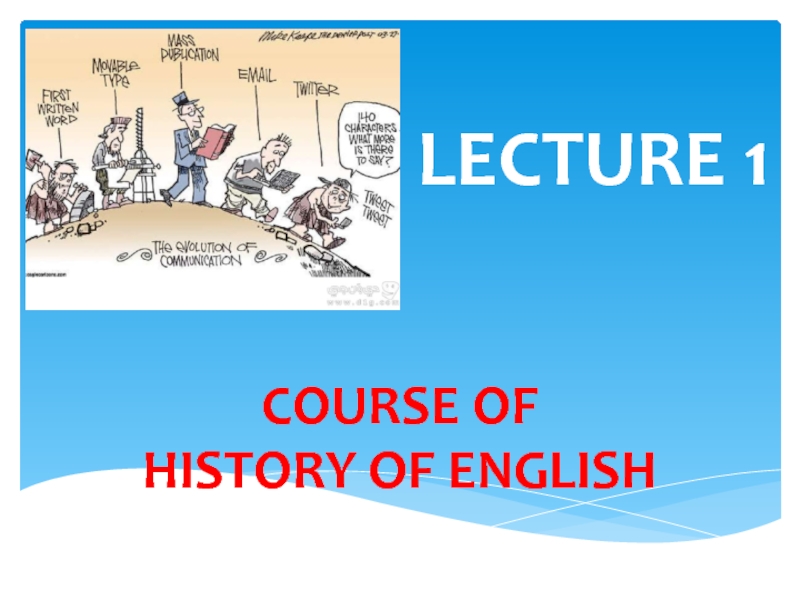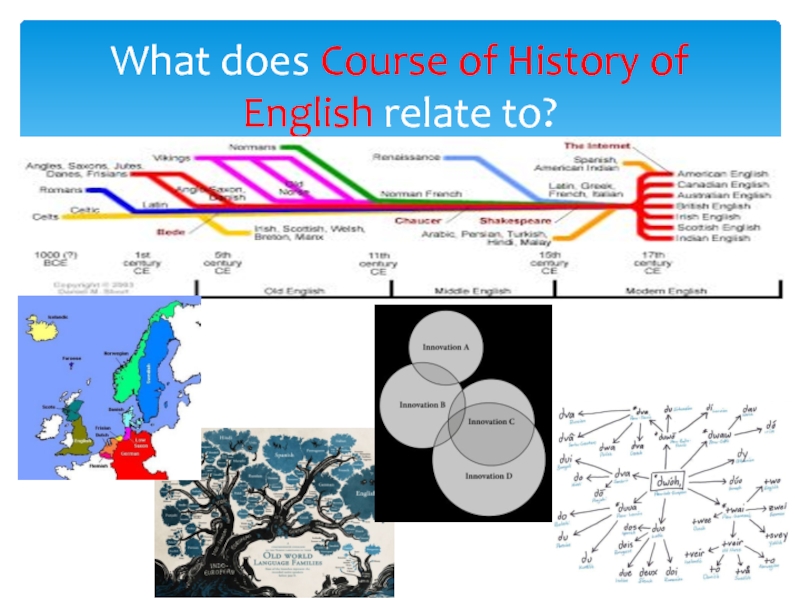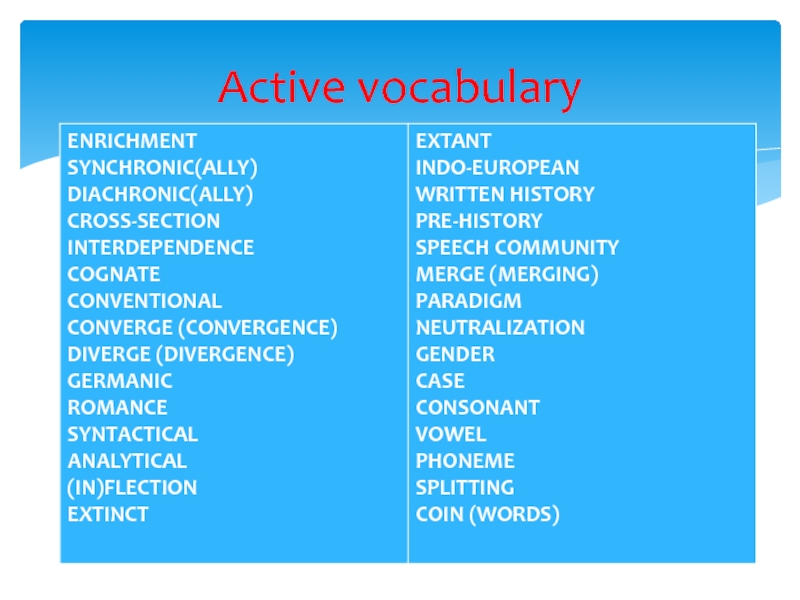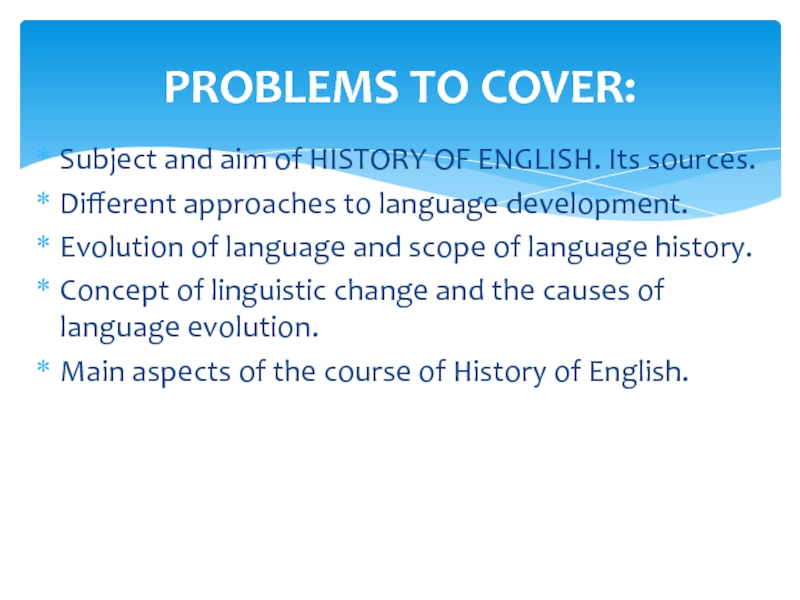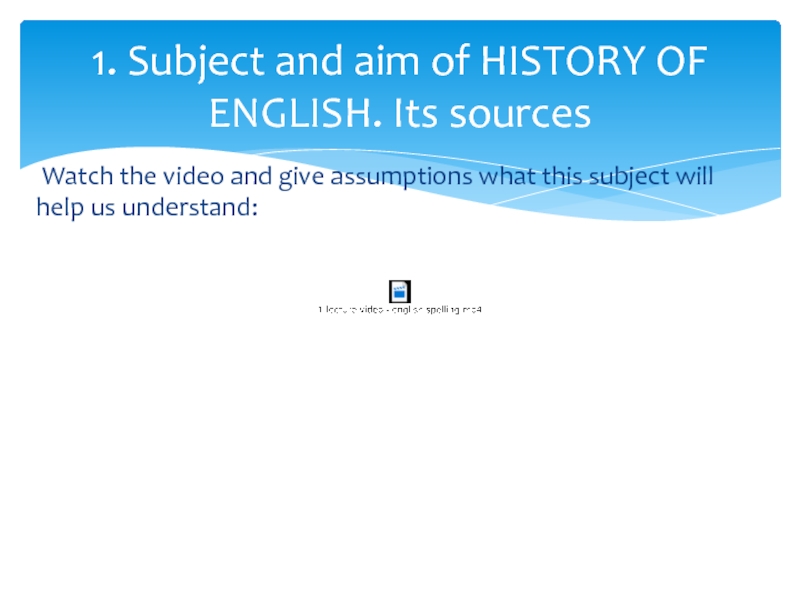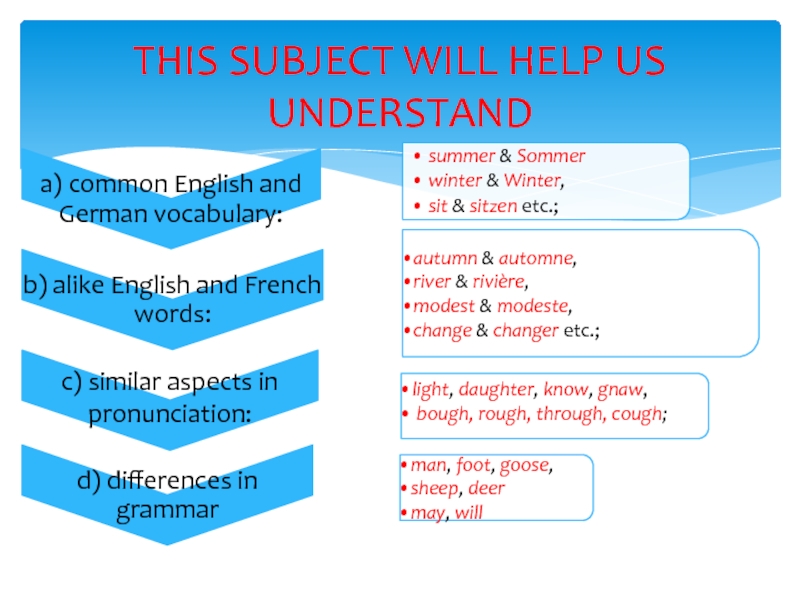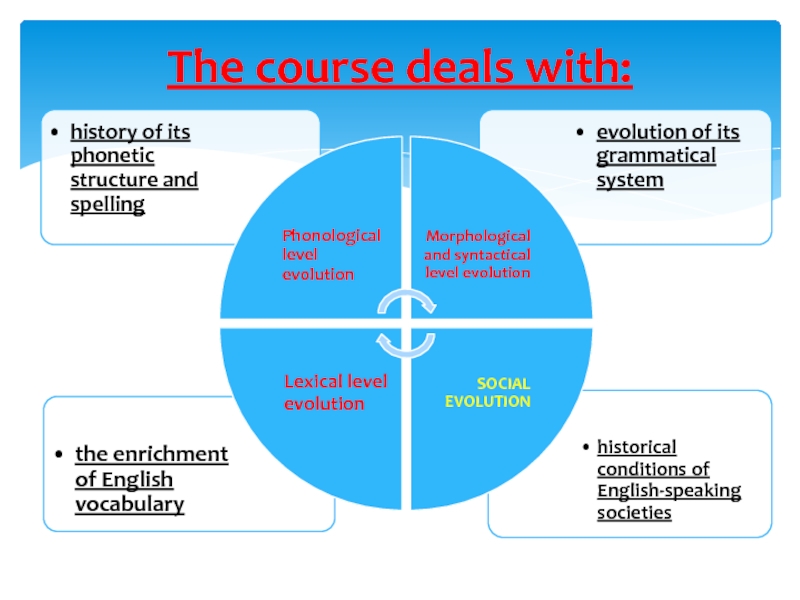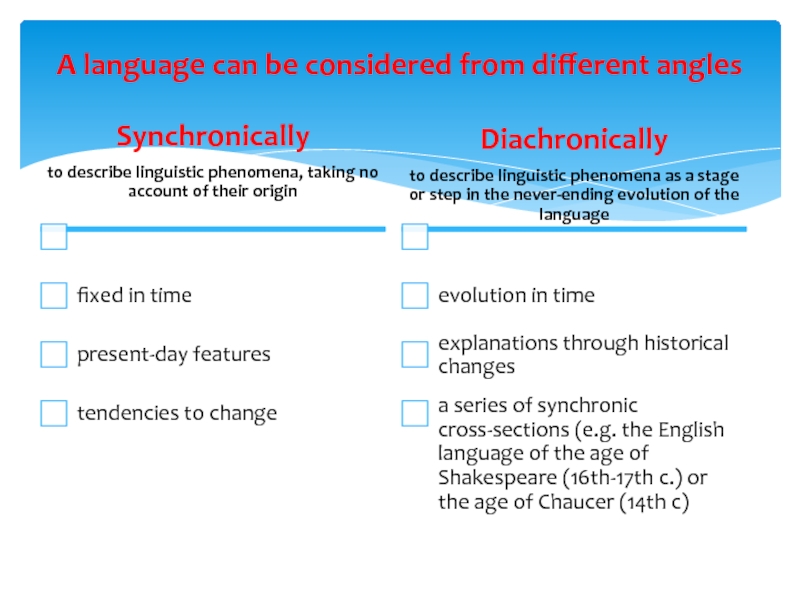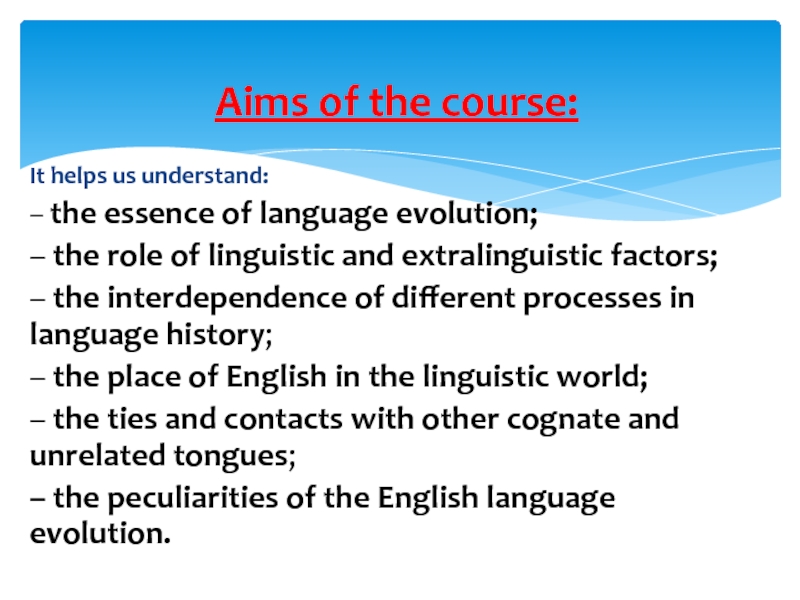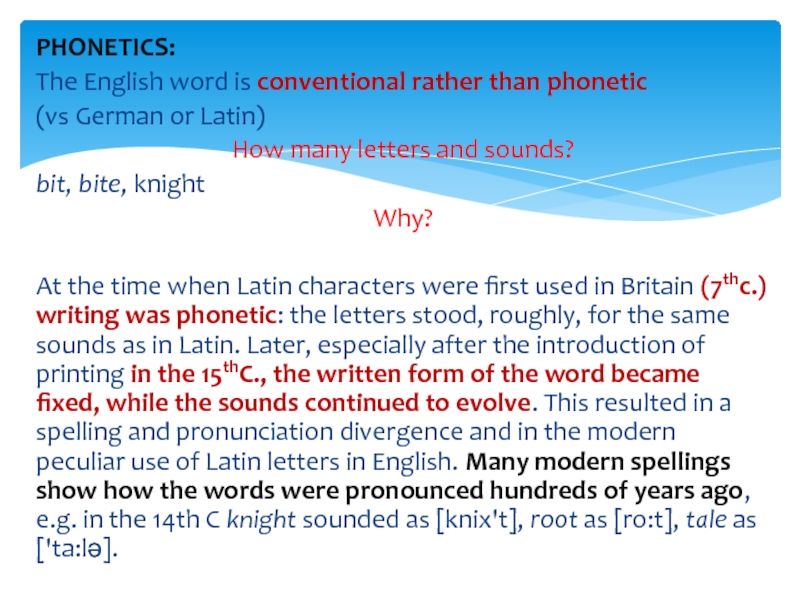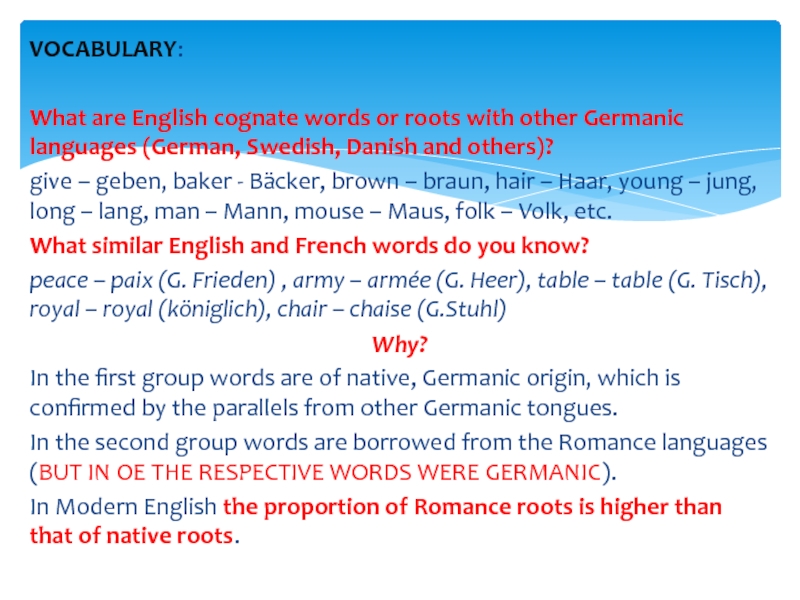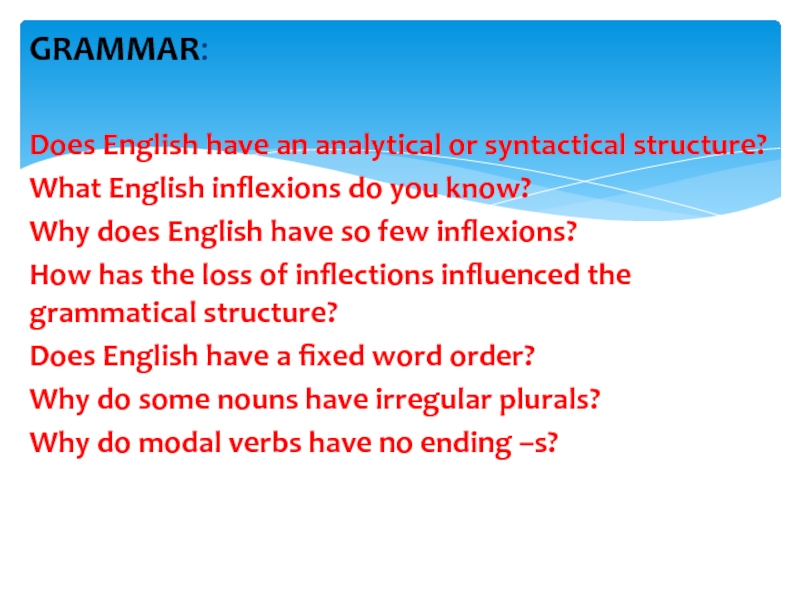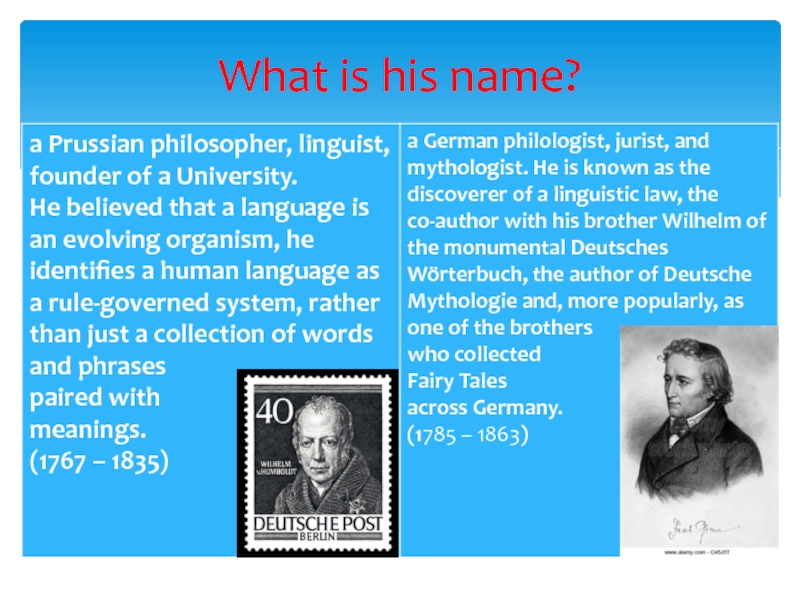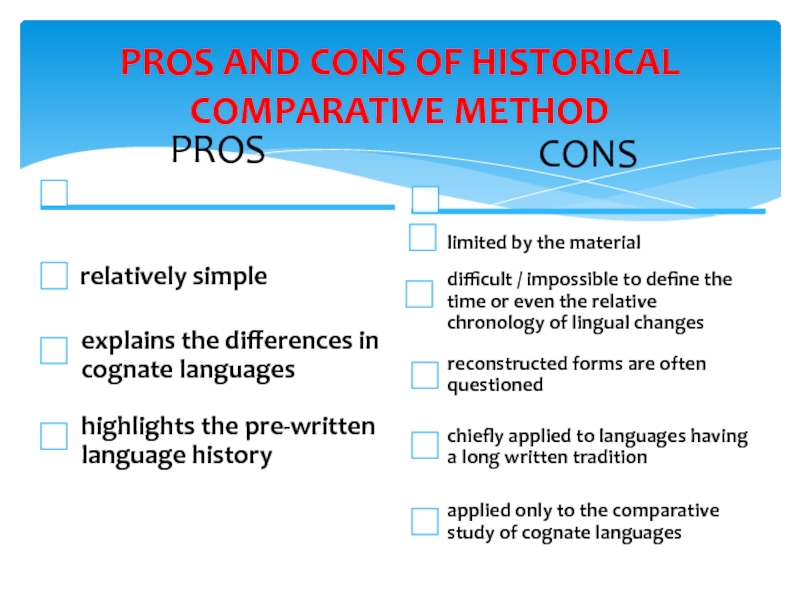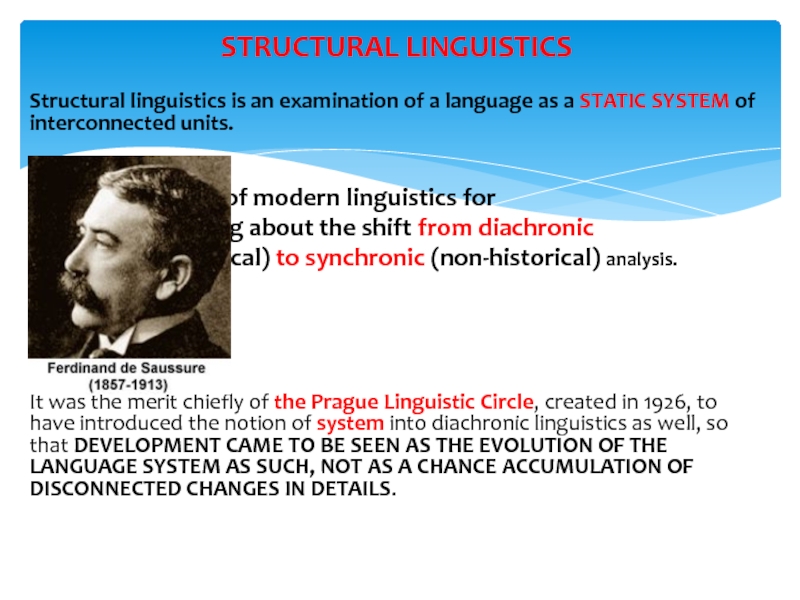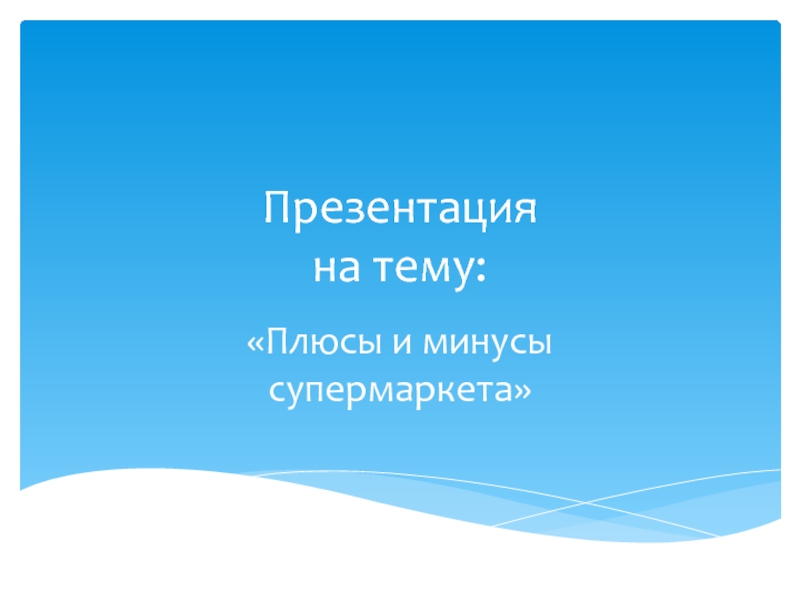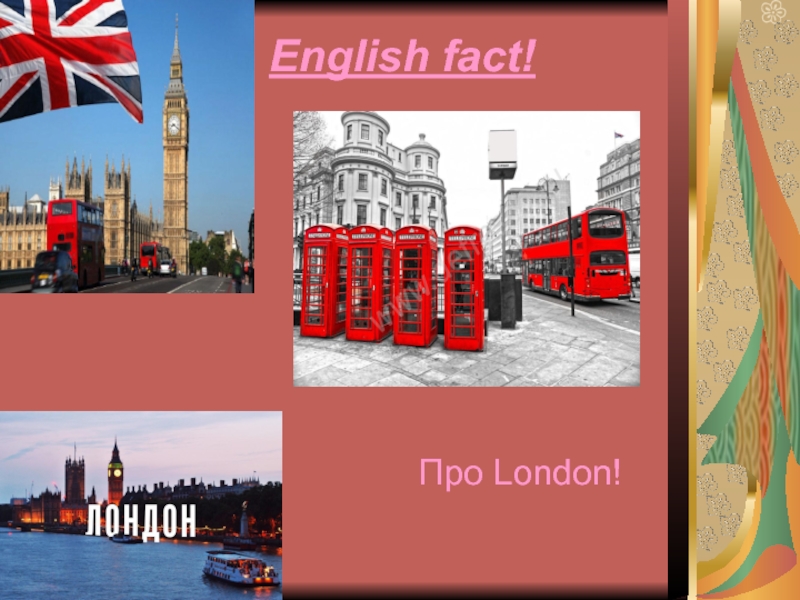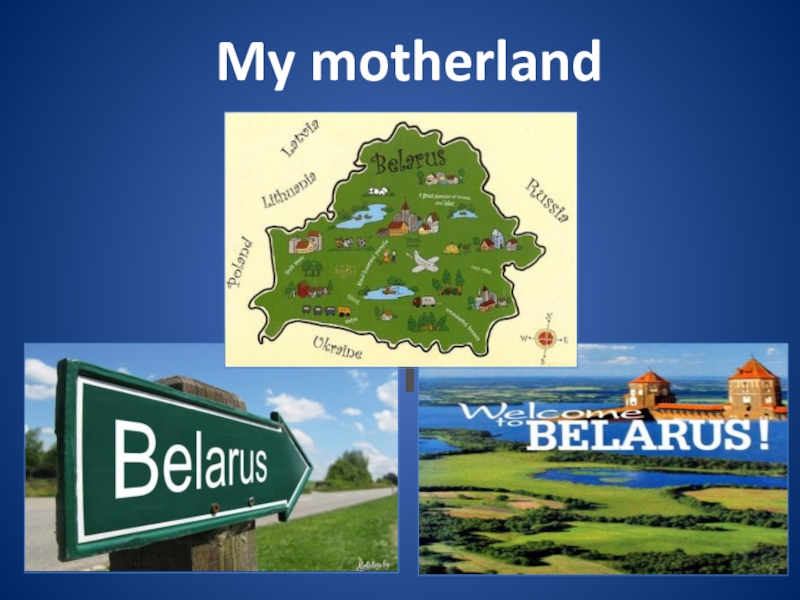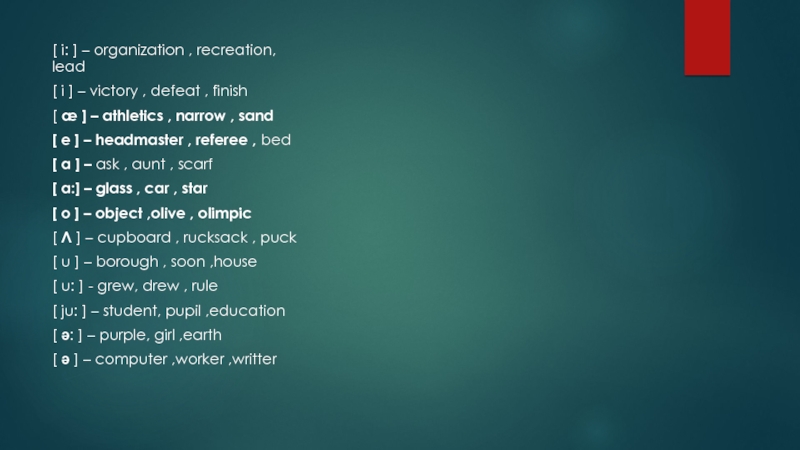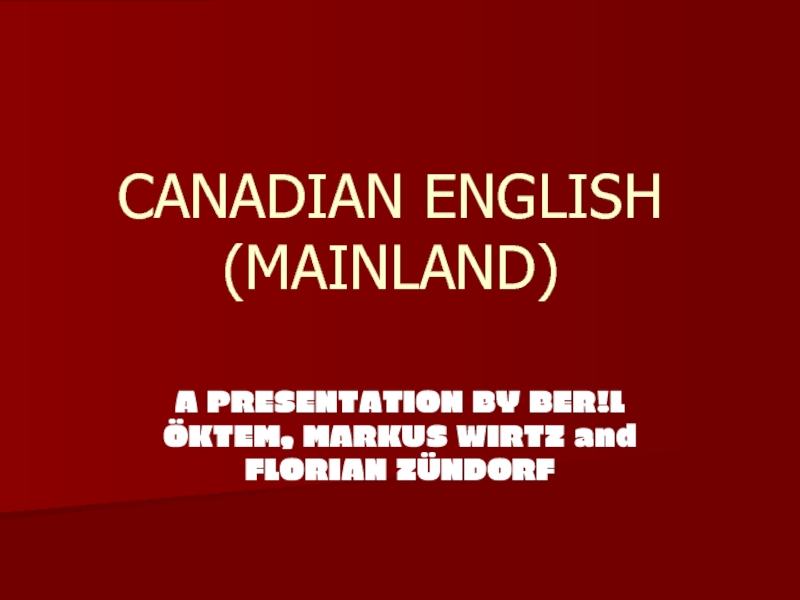- Главная
- Разное
- Дизайн
- Бизнес и предпринимательство
- Аналитика
- Образование
- Развлечения
- Красота и здоровье
- Финансы
- Государство
- Путешествия
- Спорт
- Недвижимость
- Армия
- Графика
- Культурология
- Еда и кулинария
- Лингвистика
- Английский язык
- Астрономия
- Алгебра
- Биология
- География
- Детские презентации
- Информатика
- История
- Литература
- Маркетинг
- Математика
- Медицина
- Менеджмент
- Музыка
- МХК
- Немецкий язык
- ОБЖ
- Обществознание
- Окружающий мир
- Педагогика
- Русский язык
- Технология
- Физика
- Философия
- Химия
- Шаблоны, картинки для презентаций
- Экология
- Экономика
- Юриспруденция
Course of history of english презентация
Содержание
- 1. Course of history of english
- 2. What does Course of History of English relate to?
- 3. Active vocabulary
- 4. Subject and aim of HISTORY OF ENGLISH.
- 5. Watch the video and give assumptions
- 6. THIS SUBJECT WILL HELP US UNDERSTAND
- 7. The course deals with:
- 8. A language can be considered from different
- 9. Aims of the course:
- 10. PHONETICS: The English word is conventional rather
- 11. VOCABULARY: What are English cognate words
- 12. GRAMMAR: Does English have an analytical
- 13. How often do languages develop?
- 14. HISTORICAL COMPARATIVE METHOD early 19th
- 15. QUIZZ: What is his name?
- 16. What is his name?
- 17. What is his name?
- 19. STRUCTURAL LINGUISTICS Structural linguistics is an
- 20. Everyone: Learn theoretical aspects of language evolution.
- 21. Thank you for attention !!!!!
Слайд 4Subject and aim of HISTORY OF ENGLISH. Its sources.
Different approaches to
language development.
Evolution of language and scope of language history.
Concept of linguistic change and the causes of language evolution.
Main aspects of the course of History of English.
Evolution of language and scope of language history.
Concept of linguistic change and the causes of language evolution.
Main aspects of the course of History of English.
PROBLEMS TO COVER:
Слайд 5 Watch the video and give assumptions what this subject will
help us understand:
1. Subject and aim of HISTORY OF ENGLISH. Its sources
Слайд 9
Aims of the course:
It helps us understand:
– the essence of
language evolution;
– the role of linguistic and extralinguistic factors;
– the interdependence of different processes in language history;
– the place of English in the linguistic world;
– the ties and contacts with other cognate and unrelated tongues;
– the peculiarities of the English language evolution.
– the role of linguistic and extralinguistic factors;
– the interdependence of different processes in language history;
– the place of English in the linguistic world;
– the ties and contacts with other cognate and unrelated tongues;
– the peculiarities of the English language evolution.
Слайд 10PHONETICS:
The English word is conventional rather than phonetic
(vs German or
Latin)
How many letters and sounds?
bit, bite, knight
Why?
At the time when Latin characters were first used in Britain (7thc.) writing was phonetic: the letters stood, roughly, for the same sounds as in Latin. Later, especially after the introduction of printing in the 15thC., the written form of the word became fixed, while the sounds continued to evolve. This resulted in a spelling and pronunciation divergence and in the modern peculiar use of Latin letters in English. Many modern spellings show how the words were pronounced hundreds of years ago, e.g. in the 14th С knight sounded as [knix't], root as [ro:t], tale as ['ta:lә].
How many letters and sounds?
bit, bite, knight
Why?
At the time when Latin characters were first used in Britain (7thc.) writing was phonetic: the letters stood, roughly, for the same sounds as in Latin. Later, especially after the introduction of printing in the 15thC., the written form of the word became fixed, while the sounds continued to evolve. This resulted in a spelling and pronunciation divergence and in the modern peculiar use of Latin letters in English. Many modern spellings show how the words were pronounced hundreds of years ago, e.g. in the 14th С knight sounded as [knix't], root as [ro:t], tale as ['ta:lә].
Слайд 11VOCABULARY:
What are English cognate words or roots with other Germanic languages
(German, Swedish, Danish and others)?
give – geben, baker - Bäcker, brown – braun, hair – Haar, young – jung, long – lang, man – Mann, mouse – Maus, folk – Volk, etc.
What similar English and French words do you know?
peace – paix (G. Frieden) , army – armée (G. Heer), table – table (G. Tisch), royal – royal (königlich), chair – chaise (G.Stuhl)
Why?
In the first group words are of native, Germanic origin, which is confirmed by the parallels from other Germanic tongues.
In the second group words are borrowed from the Romance languages (BUT IN OE THE RESPECTIVE WORDS WERE GERMANIC).
In Modern English the proportion of Romance roots is higher than that of native roots.
give – geben, baker - Bäcker, brown – braun, hair – Haar, young – jung, long – lang, man – Mann, mouse – Maus, folk – Volk, etc.
What similar English and French words do you know?
peace – paix (G. Frieden) , army – armée (G. Heer), table – table (G. Tisch), royal – royal (königlich), chair – chaise (G.Stuhl)
Why?
In the first group words are of native, Germanic origin, which is confirmed by the parallels from other Germanic tongues.
In the second group words are borrowed from the Romance languages (BUT IN OE THE RESPECTIVE WORDS WERE GERMANIC).
In Modern English the proportion of Romance roots is higher than that of native roots.
Слайд 12GRAMMAR:
Does English have an analytical or syntactical structure?
What English inflexions
do you know?
Why does English have so few inflexions?
How has the loss of inflections influenced the grammatical structure?
Does English have a fixed word order?
Why do some nouns have irregular plurals?
Why do modal verbs have no ending –s?
Why does English have so few inflexions?
How has the loss of inflections influenced the grammatical structure?
Does English have a fixed word order?
Why do some nouns have irregular plurals?
Why do modal verbs have no ending –s?
Слайд 13
How often do languages develop?
Do we notice language changes?
What
is language reconstruction?
What unites 4c AD (for Gothic) and 7c AD (for English)?
Is the language born together with its system of writing?
How can we find out about early stages of history of English and lifestyle of people who spoke it? Give examples.
works of ancient historians and geographers, especially Roman;
descriptions of Germanic tribes, personal names and place-names;
early borrowings from Germanic dialects into other languages;
scientific study of extant texts.
What unites 4c AD (for Gothic) and 7c AD (for English)?
Is the language born together with its system of writing?
How can we find out about early stages of history of English and lifestyle of people who spoke it? Give examples.
works of ancient historians and geographers, especially Roman;
descriptions of Germanic tribes, personal names and place-names;
early borrowings from Germanic dialects into other languages;
scientific study of extant texts.
Слайд 14HISTORICAL COMPARATIVE METHOD
early 19th C - 1920s
Language = a series
of disconnected partial changes which gradually, as if by chance, resulted in a new state of things.
Complex grammatical phenomena were seen as a mechanical result of phonetic development.
Complex grammatical phenomena were seen as a mechanical result of phonetic development.
2. APPROACHES TO LANGUAGE DEVELOPMENT
Слайд 19STRUCTURAL LINGUISTICS
Structural linguistics is an examination of a language as a
STATIC SYSTEM of interconnected units.
father of modern linguistics for
bringing about the shift from diachronic
(historical) to synchronic (non-historical) analysis.
It was the merit chiefly of the Prague Linguistic Circle, created in 1926, to have introduced the notion of system into diachronic linguistics as well, so that DEVELOPMENT CAME TO BE SEEN AS THE EVOLUTION OF THE LANGUAGE SYSTEM AS SUCH, NOT AS A CHANCE ACCUMULATION OF DISCONNECTED CHANGES IN DETAILS.
father of modern linguistics for
bringing about the shift from diachronic
(historical) to synchronic (non-historical) analysis.
It was the merit chiefly of the Prague Linguistic Circle, created in 1926, to have introduced the notion of system into diachronic linguistics as well, so that DEVELOPMENT CAME TO BE SEEN AS THE EVOLUTION OF THE LANGUAGE SYSTEM AS SUCH, NOT AS A CHANCE ACCUMULATION OF DISCONNECTED CHANGES IN DETAILS.
Слайд 20Everyone:
Learn theoretical aspects of language evolution.
Do exercises on “Language Development” handout.
Watch
episode “Birth of a Language” from “The Adventure of English” BBC documentary and do exercises.
2 project groups:
Technological progress in the 13-16 c and language evolution
Technological progress in the 20-21 c and language evolution
2 project groups:
Technological progress in the 13-16 c and language evolution
Technological progress in the 20-21 c and language evolution
Home assignment
